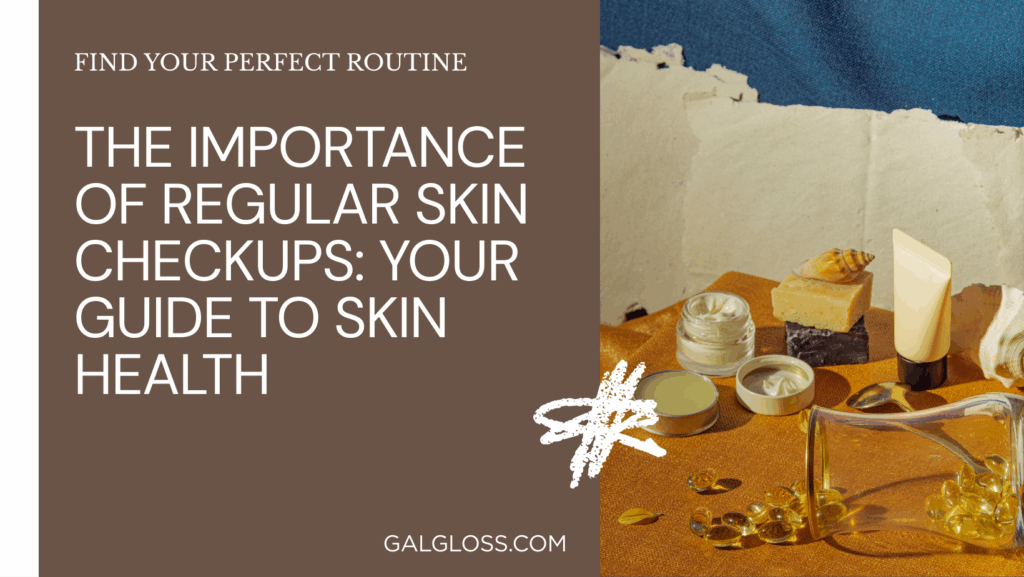Ever looked in the mirror and wondered, “Is that mole new?” or “Has that freckle always been there?” If so, you’re not alone. Our skin is constantly changing, and keeping tabs on these changes isn’t just vanity – it’s a crucial part of maintaining our health. Welcome to your crash course on why regular skin checkups are more important than that morning coffee you can’t live without!
Why Regular Skin Checkups Matter

Let’s face it – our skin is pretty amazing. It’s our body’s largest organ, our first line of defense against the outside world, and a handy barometer for our overall health. But like any superhero, it needs a little TLC to keep fighting the good fight.
Regular skin checkups are like giving your skin a high-five and a thorough once-over. They’re essential for:
- Early detection of skin cancer: Catching skin cancer in its early stages can be a game-changer. When detected early, the 5-year survival rate for melanoma (the most dangerous type of skin cancer) is a whopping 99%!
- Monitoring changes in existing moles: Remember that funky mole you’ve had since childhood? Regular checkups help track any changes that might spell trouble.
- Identifying new skin growths: New moles or lesions can pop up faster than you can say “sunscreen.” Regular checkups help spot these newcomers.
- Assessing overall skin health: Your skin can tell you a lot about your general health. Checkups can reveal issues like hormone imbalances, vitamin deficiencies, or even diabetes.
Types of Skin Cancer to Watch For
Now, don’t panic, but there are several types of skin cancer to keep an eye out for. Think of them as the villains in your skin’s superhero movie:
- Melanoma: The big bad of skin cancers. It’s less common but more dangerous, often spreading to other parts of the body if not caught early.
- Basal Cell Carcinoma (BCC): The most common type of skin cancer. It grows slowly and rarely spreads, but can be disfiguring if left untreated.
- Squamous Cell Carcinoma (SCC): The second most common type. It can spread to other parts of the body if not treated promptly.
Risk Factors for Skin Cancer
Some people are more likely to develop skin cancer than others. It’s like being dealt a certain hand in poker – you can’t change the cards, but you can learn to play them smart. Key risk factors include:
- UV exposure: Sun worshipper or tanning bed enthusiast? Your risk is higher.
- Skin type: Fair-skinned? Freckles? You’re more susceptible to UV damage.
- Family history: If skin cancer runs in your family, you might be more prone to it.
- Age and gender: As we age, our risk increases. Men are also more likely to develop skin cancer than women.
- Previous skin cancer diagnosis: If you’ve had skin cancer before, you’re at higher risk for developing it again.
The ABCDE Rule of Skin Cancer Detection
Ever heard of the ABCDE rule? No, it’s not a new diet fad. It’s a handy tool for spotting potential skin cancer. Here’s the lowdown:
- A for Asymmetry: If you drew a line through the middle of a mole, would the two halves match?
- B for Border: Are the edges ragged, notched, or blurred?
- C for Color: Is the color consistent throughout, or does it vary?
- D for Diameter: Is it larger than 6mm (about the size of a pencil eraser)?
- E for Evolving: Has it changed in size, shape, or color over time?
If you spot any of these signs, it’s time to book that skin checkup pronto!
How Often Should You Get a Skin Checkup?
So, how often should you be getting these checkups? Well, it depends on your risk factors:
- For most people, an annual skin exam is recommended.
- If you’re at higher risk (fair skin, family history, lots of moles), your dermatologist might suggest more frequent visits.
- Everyone should perform monthly self-exams (more on that in a bit!).
Remember, professional screenings and self-exams are like peanut butter and jelly – they work best together!
What to Expect During a Professional Skin Checkup
Nervous about your first skin checkup? Don’t be! Here’s what typically goes down:
- Initial consultation: Your doc will ask about your medical history, any concerns you have, and your sun exposure habits.
- Full-body examination: You’ll change into a gown, and the dermatologist will examine your skin from head to toe. Yes, even between your toes!
- Mole mapping: If you have lots of moles, your doc might use digital photography to track changes over time.
- Biopsy: If something looks suspicious, your dermatologist might take a small sample for testing. Don’t worry – it’s usually quick and painless!
Self-Examination Tips
Between professional checkups, it’s crucial to keep an eye on your skin yourself. Here’s how to become a self-exam pro:
- Timing: Once a month, after a shower or bath, is ideal.
- Lighting: Make sure you have good lighting – natural light is best.
- Full-body check: Use a full-length mirror and a hand mirror to check every nook and cranny.
- Don’t forget: Check your scalp, between your toes, and even your nails!
- Tech help: There are some great apps out there that can help you track changes in your moles over time.
Areas often overlooked during self-exams include the scalp, behind the ears, and yes, even your backside. Don’t be shy – your skin will thank you!
Sun Protection: Your First Line of Defense
When it comes to skin cancer prevention, sunscreen is your BFF. Here’s how to make the most of it:
- Choose wisely: Look for broad-spectrum protection with an SPF of at least 30.
- Apply generously: Most people don’t use enough. Aim for about a shot glass full for your whole body.
- Reapply often: Every two hours, or more if you’re swimming or sweating.
But don’t stop at sunscreen! Embrace your inner movie star with wide-brimmed hats, oversized sunglasses, and UV-protective clothing. And remember, shade is your friend – especially between 10 am and 4 pm when the sun is strongest.
Skin Cancer Prevention Strategies
Beyond sun protection, there are other ways to keep your skin happy and healthy:
- Lifestyle changes: Quit smoking, limit alcohol, and get regular exercise.
- Diet and nutrition: Load up on antioxidant-rich foods like berries, leafy greens, and fatty fish.
- Avoid tanning beds: Seriously, just don’t. They’re bad news for your skin.
Common Myths About Skin Cancer and Checkups
Let’s bust some myths, shall we?
- Myth: Only old people get skin cancer. Fact: Skin cancer can affect anyone, regardless of age.
- Myth: People with darker skin don’t need to worry about skin cancer. Fact: While less common, skin cancer in people with darker skin is often diagnosed at later stages.
- Myth: If you tan easily, you’re not at risk for skin cancer. Fact: Any change in skin color is a sign of damage. There’s no such thing as a “healthy tan.”
Finding a Qualified Dermatologist
Ready to book that skin checkup? Here’s what to look for in a skin doc:
- Board certification in dermatology
- Experience with skin cancer detection and treatment
- Up-to-date with the latest screening technologies
Don’t be afraid to ask questions during your visit. A good dermatologist will be happy to address your concerns and explain everything in detail.
Conclusion
Whew! We’ve covered a lot of ground, haven’t we? From the ABCDEs of skin cancer detection to busting common myths, you’re now armed with the knowledge to take charge of your skin health.
Remember, regular skin checkups are more than just a quick once-over – they’re an investment in your long-term health and wellbeing. They’re your secret weapon in catching potential issues early when they’re most treatable.
So, what are you waiting for? It’s time to show your skin some love! Book that dermatologist appointment, start those monthly self-exams, and slather on that sunscreen like your life depends on it (because, in a way, it does).
Your skin has been protecting you your whole life. Now it’s your turn to return the favor. Trust me, future you will be grateful for the care you’re taking today. Here’s to healthy, happy skin for years to come!





